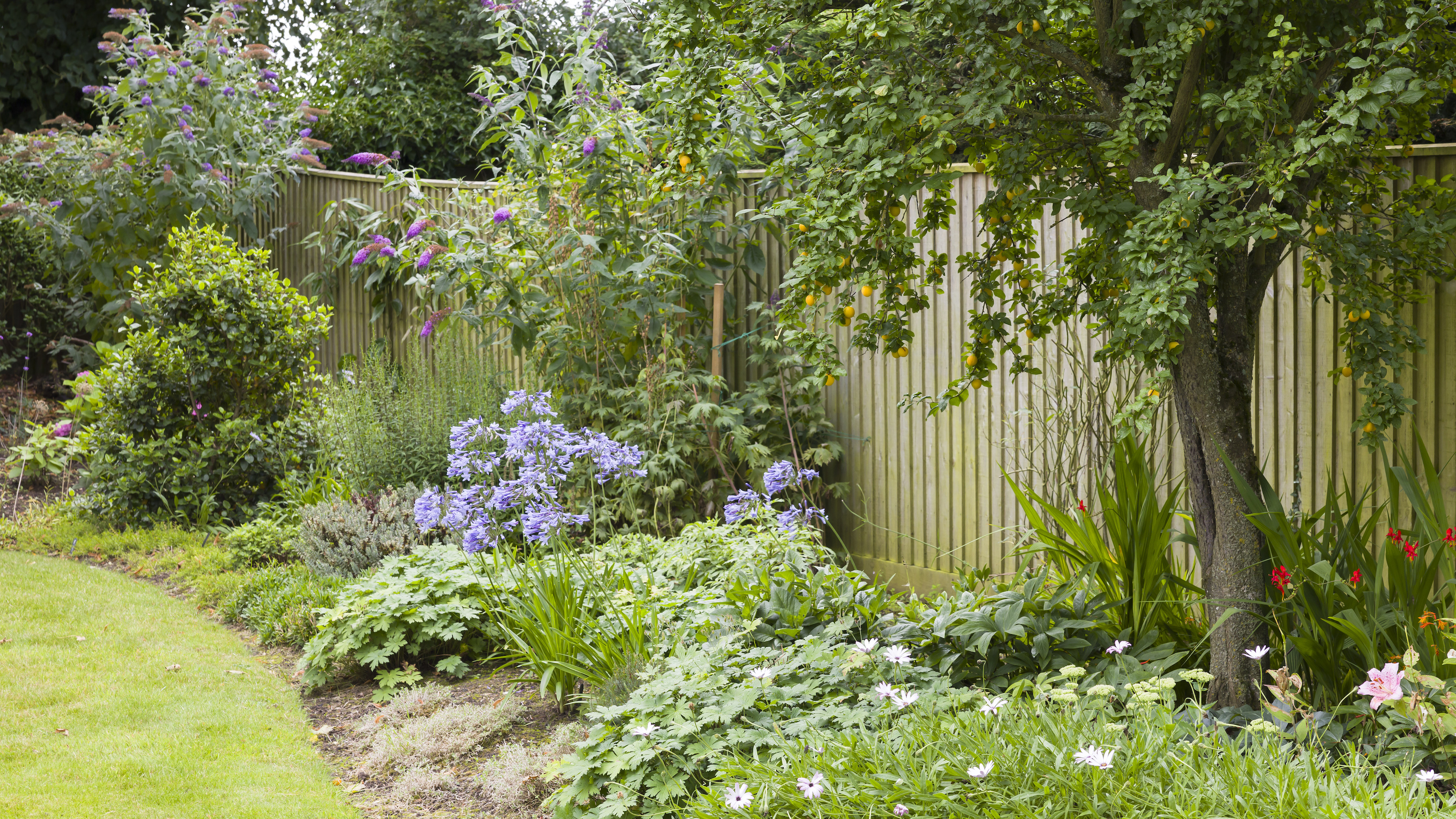5 most common tree disputes with neighbours — and how to resolve them
Garden trees can be a source of conflicts between homeowners. Here’s what you need to know to clear them up

Trees can be a fabulous feature, adding height, creating shade, and introducing beautiful foliage, and in some cases fruit or nuts to a garden. But these attributes can also be the cause of common tree disputes with neighbours.
As trees grow, their roots and branches can cross the boundary between neighbours, and their canopies can reduce the amount of light reaching an area. Meanwhile, depending on the tree species, leaves, fruit and nuts can fall into an adjoining garden. And although these occurrences are natural, they can become a source of friction between you and next door.
Below, we take a look at what causes the most frequent arguments about trees between neighbours. Plus, so you can resolve them within the law, we’ve got what you need to know about your rights and liabilities regarding garden trees.
Tree preservation orders and conservation areas
Below are the five most common tree disputes that arise between neighbours and guidance on what you should do whether you are the tree owner or the person who lives next door to the tree.
Always bear in mind, however, that trees can be covered by Tree Preservation Orders (TPOs) or be in a conservation area and will thus require consent to be obtained from the local authority if you want to take an action such as cutting off overhanging branches, or cutting encroaching tree roots (see below).
1. Overhanging branches
Branches from a tree in one garden that overhang next door’s garden can become a source of friction between neighbours. What you need to know, though, is that the person whose property is overhung has the right to cut back the branches – but only to the property boundary.
You don’t have to ask if it’s your garden that’s overhung, but doing so is likely to make for better neighbourly relations. Alternatively, you could ask your neighbour to cut the branch back.
Bring your dream home to life with expert advice, how to guides and design inspiration. Sign up for our newsletter and get two free tickets to a Homebuilding & Renovating Show near you.
If it’s you doing the cutting? You cannot trespass onto your neighbour’s property to do so although you could ask their consent. Bear in mind, too, that you need to offer the branches you cut back to the owner of the tree; don’t throw anything over the fence. If the owner doesn’t want the trimmings, you can dispose of them.
Think tree health before taking off an overhanging branch. “Cutting large limbs without care can destabilise or stress the tree, potentially making you liable for damage, especially if the tree is protected by a TPO or is within a conservation area,” explains Simon Rotheram, qualified arboriculturist and director of Beechwood Trees & Landscapes.

With over 25 years of hands-on experience, qualified arboriculturist Simon Rotheram is the founder and managing director of Beechwood Trees and Landscapes. He has built the company from the ground up into a nationally recognised leader in tree surgery and vegetation management. His deep industry knowledge, combined with a long-standing commitment to training and mentoring professionals, makes him highly qualified.
2. Encroaching roots
Just as with overhanging branches, you can cut your neighbour’s tree roots if they encroach into your garden. Again, trim only up to the boundary, never beyond.
There’s a caveat, however. Be aware of the risks of damaging the tree because if it subsequently fell over or died, your neighbour could lodge a claim against you. Getting professional advice is well worthwhile before proceeding.
Roots from a tree in the adjoining garden might also be the source of a dispute over damage to the next door home. “If a neighbour can provide evidence that your tree is causing actual damage, such as structural cracks or subsidence, they may bring a claim in nuisance and require you to remedy the issue,” explains Jack Bassett, consultant litigation solicitor at Setfords.
“They may even apply to court for an injunction compelling you to carry out remedial works and seek damages for any loss. You are not, however, obliged to act based on suspicion alone and therefore requesting evidence of damage is reasonable; choosing to ignore that evidence may result in legal liability though.”

Jack Bassett is a consultant litigation solicitor at Setfords specialising in property and commercial disputes, with particular expertise in neighbour boundary issues, nuisance claims, and litigation involving land and property rights. He advises clients ranging from homeowners to property developers on resolving complex disputes pragmatically and cost-effectively.
3. Obstruction of light or views
As a tree grows it can change the level of light that reaches an adjoining garden or block a view, and whether you’re the tree owner or next door to it, it’s important to know what the law says to avoid a dispute.
“There is no general right to a view under English law,” explains Jack Bassett. “While a legal right to light can arise, this typically applies to permanent structures like buildings or walls. Trees, by contrast, grow gradually over time, making it difficult to pinpoint when the obstruction began. As a result, the courts rarely apply right to light claims to tree growth.
“It is worth noting that under the high hedges provisions of the Anti-social Behaviour Act 2003, evergreen/semi-evergreen hedges above 2m in height are deemed anti-social and you may be required to trim these down,” Jack adds. “Outside of this, there is no automatic legal obligation to reduce or remove a tree simply because it affects light or views.”
4. Fallen leaves, fruits and nuts
Deciduous trees shed their leaves, but the owner of a tree is not obliged to collect the leaves that fall from their tree into a neighbour’s garden. If you are concerned that leaves from a neighbour’s tree are causing damage, however, such as blocking your drains, write to your neighbour to let them know.
As for fruit or nuts, whether on an overhanging branch or windfalls, these remains the possession of a neighbour, so stay on the right side of the law by asking their permission if you want this produce.
5. Fallen branches or trees
Tree branches can break off in the course of a tree’s life, and trees can fall or break in particularly stormy weather. They can also suffer from disease that weakens them. As a result the tree could cause injury to a neighbour or damage to a neighbour’s property and the tree owner might be liable if they haven’t inspected the tree regularly.
“Regular inspections aren’t just about tree health; they’re about preventing disputes before they arise,” explains Simon Rotheram. “A proactive approach helps tree owners: spot structural risks (eg deadwood, decay, or root plate movement); identify whether their tree is causing nuisance or obstruction; and protect themselves legally by showing they’ve taken reasonable care, a key point if a dispute escalates. Regular, documented inspections, ideally by a qualified arboriculturist, are key to protecting both safety and relationships.”
Trees in one person’s garden can impact on the next door property so it’s essential to understand both party’s rights and liabilities. If a tree is on the boundary? It may be jointly owned and you should always get the other owner’s permission before doing any work on a tree. And if you have doubts about whose land the tree is on, get legal advice on ownership.
Sarah is a freelance journalist and editor writing for websites, national newspapers, and magazines. She’s spent most of her journalistic career specialising in homes.
She loves testing the latest home appliances and products, and investigating the benefits, costs and practicalities of home improvement. She is an experienced renovator and is currently remodelling the ground floor of her new home.
She was Executive Editor of Ideal Home and has worked for Your Home and Homes & Ideas. Her work has published by numerous titles, including The Guardian, channel4.com, Houzz, Grand Designs, Homes & Gardens, House Beautiful, Homes & Antiques, Real Homes, The English Home, Period Living, Beautiful Kitchens, Good Homes and Country Homes & Interiors.
